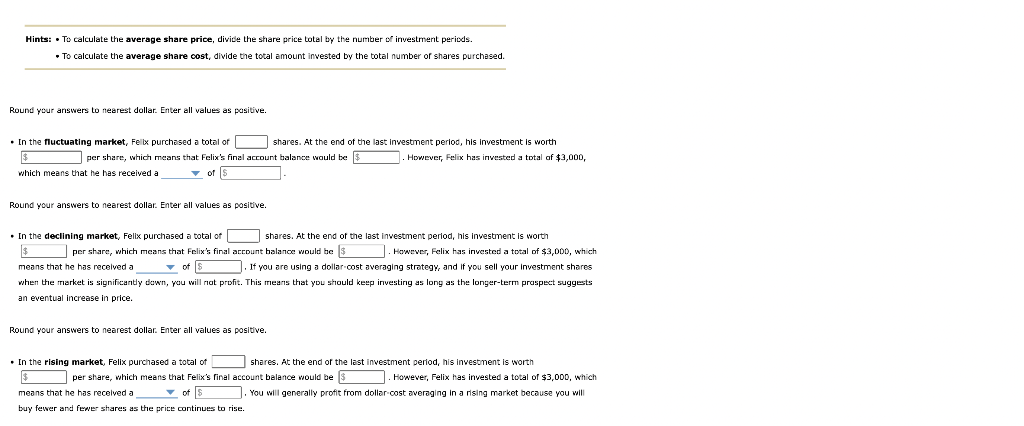

Regular Investment Period 1: $600 : Fluctuating Market Share Price $30 Shares Acquired 20 25 24 30 20 Period 2: S00 Period 3: 600 Period 4: son Period S: 600 25 24 30 20 Totals: $3,000 $140 108 $ Average share price: Average share cost $ Declining Market Share Price Regular Investment Shares Acquired Period 1: $600 $30 20 500 25 Period 2: Period 3 600 25 500 20 Period 4: Period 5: Tatals: 600 15 $2,000 $115 Average share price: Averege share cost: ............. Rising Market Share Price $10 Shares Acquired Regular Investment Period 1: $600 Period 2 500 Perlod 3 600 Period 4: 600 15 20 25 30 Period 5: 500 5: Totals: $3,000 $100 Average share price: Average share cost: Hints: To calculate the average share price, divide the share price total by the number of investment periods. To calculate the average share cost, divide the total amount invested by the total number of shares purchased. Round your answers to nearest dollar. Enter all values as positive. . In the fluctuating market, Felix purchased a total or shares. At the end of the last investment period, his investment is worth per share, which means that Felix's final account balance would be However, Felix has invested a total of $3,000, which means that he has received a of S Round your answers to nearest dollar. Enter all values as positive. In the declining market, Felix purchased a total of shares. At the end of the last investment period, his investment is worth $ per share, which means that Felix's final account balance would be s J. However, Felix has invested a total of $3,000, which means that he has received a of S. If you are using a dollar-cost averaging strategy, and if you sell your investment shares when the market is significantly down, you will not profit. This means that you should keep investing as long as the longer-term prospect suggests an eventual increase in price. Round your answers to nearest dollar. Enter all values as positive. . In the rising market, Felix purchased a total of shares. At the end of the last investment period, his investment is worth per share, which means that Felix's final account balance would be $ However, Felix has invested a total of $3,000, which means that he has received a of $. You will generally profit from dollar-cost averaging in a nising market because you will buy fewer and fewer shares as the price continues to rise. Regular Investment Period 1: $600 : Fluctuating Market Share Price $30 Shares Acquired 20 25 24 30 20 Period 2: S00 Period 3: 600 Period 4: son Period S: 600 25 24 30 20 Totals: $3,000 $140 108 $ Average share price: Average share cost $ Declining Market Share Price Regular Investment Shares Acquired Period 1: $600 $30 20 500 25 Period 2: Period 3 600 25 500 20 Period 4: Period 5: Tatals: 600 15 $2,000 $115 Average share price: Averege share cost: ............. Rising Market Share Price $10 Shares Acquired Regular Investment Period 1: $600 Period 2 500 Perlod 3 600 Period 4: 600 15 20 25 30 Period 5: 500 5: Totals: $3,000 $100 Average share price: Average share cost: Hints: To calculate the average share price, divide the share price total by the number of investment periods. To calculate the average share cost, divide the total amount invested by the total number of shares purchased. Round your answers to nearest dollar. Enter all values as positive. . In the fluctuating market, Felix purchased a total or shares. At the end of the last investment period, his investment is worth per share, which means that Felix's final account balance would be However, Felix has invested a total of $3,000, which means that he has received a of S Round your answers to nearest dollar. Enter all values as positive. In the declining market, Felix purchased a total of shares. At the end of the last investment period, his investment is worth $ per share, which means that Felix's final account balance would be s J. However, Felix has invested a total of $3,000, which means that he has received a of S. If you are using a dollar-cost averaging strategy, and if you sell your investment shares when the market is significantly down, you will not profit. This means that you should keep investing as long as the longer-term prospect suggests an eventual increase in price. Round your answers to nearest dollar. Enter all values as positive. . In the rising market, Felix purchased a total of shares. At the end of the last investment period, his investment is worth per share, which means that Felix's final account balance would be $ However, Felix has invested a total of $3,000, which means that he has received a of $. You will generally profit from dollar-cost averaging in a nising market because you will buy fewer and fewer shares as the price continues to rise








